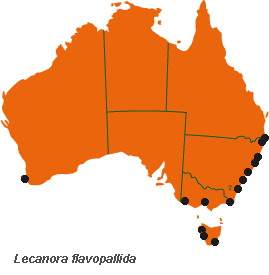



Australian Biological Resources Study
| Checklist of the Lichens of Australia and its Island Territories | ||
| Introduction | A–D | E–O | P–R | S–Z | Oceanic Islands | References | ||
| Lecanora flavopallida Stirt. | ||
| J. Linn. Soc., Bot. 14: 463 (1875). T: near Wellington, New Zealand, J.Buchanan 82d; lecto: BM, fide D.J.Galloway, Fl. New Zealand Lichens 216 (1985). ****Lecanora lineolata Müll.Arg., Bull. Herb. Boissier 1: 38 (1893). T: Mt Macedon, Vic., F.R.M.Wilson 374; holo: G. ****Lecanora glaucoflavens Müll.Arg., Bull. Herb. Boissier 1: 39 (1893); Lecidea glaucoflavens (Müll.Arg.) R.W.Rogers, Muelleria 5: 32 (1982). T: Vic., F.R.M.Wilson 457; lecto: G, n.v., fide R.W.Rogers, loc. cit. | ||
| Thallus rimose-areolate to verruculose, yellowish grey to greyish green or whitish grey, smooth, sometimes glossy. Soredia absent. Prothallus not visible or whitish grey. Apothecia sessile to adnate, 0.5–1.7 mm diam.; disc pale orange to brown, with a thin whitish grey pruina or epruinose, plane when immature, soon becoming convex; margin prominent, becoming excluded or persisting and flexuose, smooth, entire, whitish to whitish grey. Cortex absent. Amphithecium with large and small crystals; small crystals soluble in KOH; algae absent or present in basal parts of the amphithecium. Parathecium hyaline, with small crystals, c. 20 µm thick. Subhymenium hyaline, c.15 µm thick. Hypothecium yellow to yellowish brown; upper part hyaline to yellowish. Epihymenium granulose with small crystals soluble in KOH, brown to yellowish brown, becoming colourless in KOH, 10–20 µm thick. Hymenium hyaline, 110–160 µm thick. Paraphyses sparingly branched, not to slightly thickened apically. Ascospores ellipsoidal to broadly ellipsoidal, 14–19 × 9–12 µm. CHEMISTRY: Thallus and apothecial margin K+ yellow, C+ orange, Pd+ yellow; containing arthothelin (major), thiophanic acid (major), atranorin (minor), 2,7-dichloronorlichexanthone (minor), 2,4,7-trichloronorlichexanthone (minor) and chloroatranorin (trace). |  |
|
| A corticolous species in mangroves and coastal heaths in W.A., N.S.W., Vic. and Tas. Also in New Zealand. | ||
| Lumbsch & Elix (2004) | ||
| Checklist Index |
| Introduction | A–D | E–O | P–R | S–Z | Oceanic Islands | References |
This work is copyright. Apart from any use as permitted under the Copyright Act 1968, no part may be reproduced by any process without prior written permission from Australian Biological Resources Study. Requests and inquiries concerning reproduction and rights should be addressed in the first instance to Dr P. McCarthy. These pages may not be displayed on, or downloaded to, any other server without the express permission of ABRS.